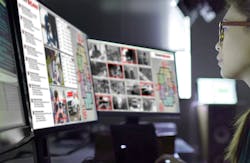Layered security solutions adapted to battle COVID-19
When a Canadian-based technology company launched its covert-threat detection solutions in 2016, the endgame was to employ artificial intelligence in a network of hidden sensors that were capable of detecting concealed weapons (on-body or in-bag), chemicals and bombs through its complex algorithms, multiple sensors and AI-enhanced video analytics. This layered approach of integrated technologies and specialized devices found a niche in securing everything from outdoor venues and building entrances to high-security building interiors or wherever covert proactive security was essential.
But as with almost every global organization, the still-raging COVID-19 pandemic has forced CEO/Director Martin Cronin to adapt his business and its current technology solutions to the new crisis landscape. For Cronin and the technical team at PatriotOne Technologies, their collective experience gained by years of working out in the field and working with clients in a variety of real-world environments that required more than a single-technology solution provided them the expertise to handle the challenge required by their clients for low-cost, unobtrusive sensors that could be deployed discreetly, covertly, and that allowed people to pass seamlessly into a building and not be subjected to a physical search or intrude on their personal privacy.
“We wanted to be on the right side of this delicate balance between surveillance and civil liberties. While we were developing solutions that would be highly valuable to security professionals, we were also conscious of public acceptance and not trampling over people's civil liberties. Having found that one single technology wouldn't do everything we required; we began a process of assimilating other streams of technology. We developed what we call a multi-sensor platform where we have radar, magnetic resonance, machine vision, and chemical sensing that all live on an AI-powered platform that uses a neural network engine to analyze the data that comes off different sensors so operators can make sense of that picture,” explains Cronin. “We're in the business of keeping people safe by identifying threats. By virtue of our solution’s ability to use a low cost, unobtrusive, small network sensors, it really opens up almost every part of the economy to this type of screening. We're not just talking about airports, ports of entry, but we're talking about public schools, retail, tourism, hospitality and mass transportation. Anywhere where the public gathers and may be at risk of acts of violence are places where we see the application for all this technology.”
A New Crisis Creates a New Vision
Now fast-forward to early 2020 as the COVID-19 pandemic began its relentless trek across the globe from China. In less than four months, the virus has afflicted more than 2.5 million Americans and killed another 120,000, with predictions of 200,000 dead citizens before Christmas. The focus of business enterprises and public facilities has suddenly shifted from security to keeping people safe from pathogens. According to Cronin, the coronavirus was simply seen as just another threat.
“This situation is no different from detecting guns, knives, or bombs. The pathogen is another threat and so we have applied our skills and tools to address it,” says Cronin.
The technology team immediately asked what solutions could be developed that would be relevant to this space. They took their expertise in the AI world and launched a thermal screening solution that could detect elevated body temperature. And yes, Cronin is well aware that thermal detection has emerged as the poster child of yet another opportunistic tech boondoggle reminiscent of facial recognition following the 9-11 attacks almost two decades ago.
“People are desperate for a solution, we all need to do something and obviously, people want to get the economy going again and…right now, everyone's worried about somebody coming into a building with an elevated temperature. We all hope, however, that in six months' time that’s no longer a concern. But my own view is we will be dealing with outbreaks of COVID for a long time to come, so we need a response that can be switched on and off as required,” Cronin says. “Why not have that capability on a platform that is also doing all these other things; detecting weapons coming into a facility, detecting fights and disturbances that are integrated with the thermal temperature capability. This would provide year-round and long-term solutions that go beyond the challenge you're facing right now.”
Meeting the Challenge
Cronin explains that his technology uses AI to do anomaly detection. After establishing the baseline, The PATSCAN Multi-Sensor Covert Threat Detection Platform can identify the people who fall outside the criteria range and they also feature a module to detect whether people are wearing masks, which in areas where they may be mandated -- like food processing plants – is a key determinant. One feature that the company is developing has taken on even more urgency given the current circumstances of reopening business operations. It is designed around what Cronin and his team call recursive tracking, meaning if a person comes into a facility with an elevated temperature, monitoring personnel is able to track where that person has been, who they interacted with and what they touched so security doesn’t have to shut down an entire facility as a precaution to contain an outbreak.
“We've also been doing some pure AI stuff around working with Amazon Web Services and Vancouver General Hospital where we can access your network lung scans to look at the progression of the disease. We've done some modeling around the spread of the pandemic and a number of other sorts of screening solutions in this tracking space,” Cronin adds. “So we really not so much pivoted because we just saw the biological threats as just another threat, but we've added some additional capabilities and solutions onto our platform that are relevant to the biggest risk challenge of our time with the goal of getting business operations up and running while keeping the people who go into those businesses safe.”
Keeping Expectations Real
Cronin sees similarities in the technology curve of newly deployed thermal cameras that have been thrust into applications they are not capable of handling and the growing dependence of AI on myriad platforms. The migration toward AI-based and machine intelligence in the security industry has been a mixture of science fiction and reality in some instances. He insists that some professionals, whether they're integrators, consultants, or end users really don't know how to properly plan for and implement technology that is unfamiliar.
“A lot of people have labored under the illusion that you just get a commercial thermal camera, throw it up, and there you go, you can detect fevers. But the tolerance of commercial off-the-shelf thermal cameras isn't there to give you that precise determination. You have plus or minus five degrees. Expectations for AI are also sometimes skewed,” says Cronin, adding that his company is realistic about what you can do with AI.
Cronin is adamant that the absolute best security tool is a well-trained observant individual.
“Human intelligence still vastly surpasses the machine intelligence. We're certainly not believers that you just hand over security to machines. We accept the fact that humans are actually extremely good at performing high-level security functions. Our view is that machines are really good at is processing very large amounts of data very, very quickly. So, let machine intelligence do that piece of it. Take complex special different sensor feeds process it, and then present the relevant information to a human who can then make a much better decision than the machine for a logical course of action,” he concludes.
About the Author: Steve Lasky is a 34-year veteran of the security publishing industry and multiple-award-winning journalist. He is currently the Editorial Director for the Endeavor Business Security Media Group, the world’s largest security media entity, serving more than 190,000 security professionals in print, interactive and events. It includes Security Technology Executive, Security Business and Locksmith Ledger International magazines, and SecurityInfoWatch.com, the most visited security web portal in the world. He can be reached at [email protected]
About the Author
Steve Lasky
Editorial Director, Editor-in-Chief/Security Technology Executive
Steve Lasky is Editorial Director of the Endeavor Business Media Security Group, which includes SecurityInfoWatch.com, as well as Security Business, Security Technology Executive, and Locksmith Ledger magazines. He is also the host of the SecurityDNA podcast series. Reach him at [email protected].

